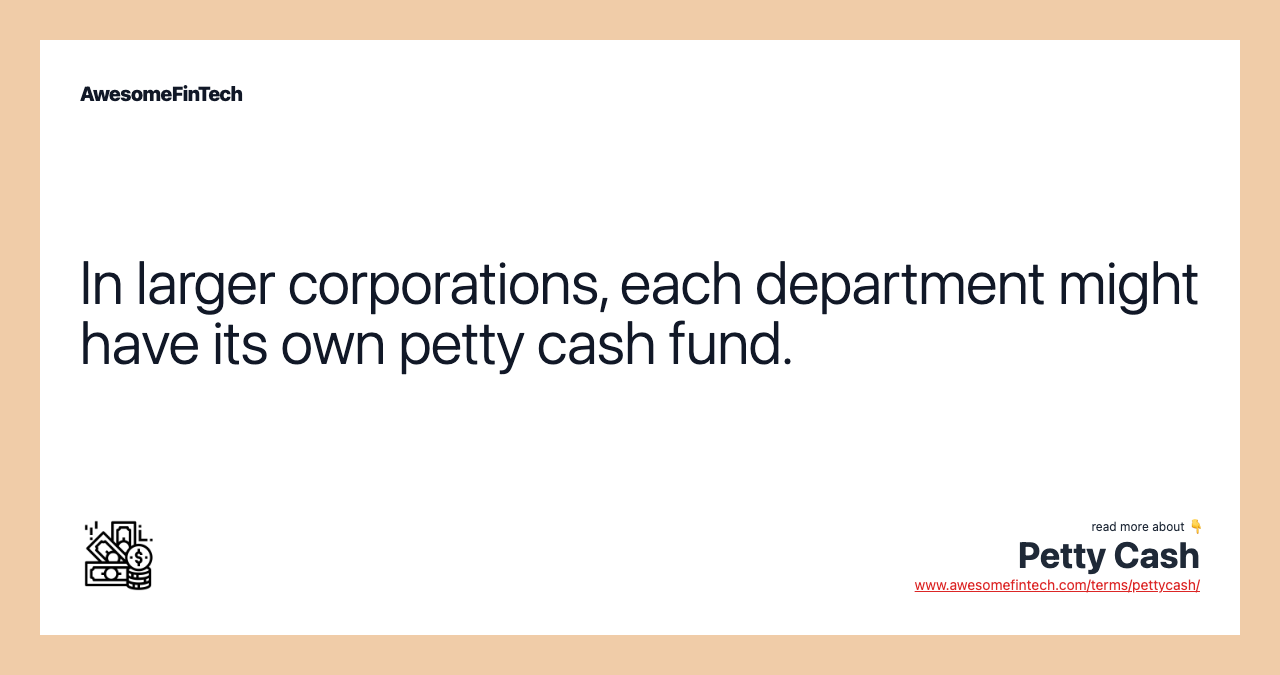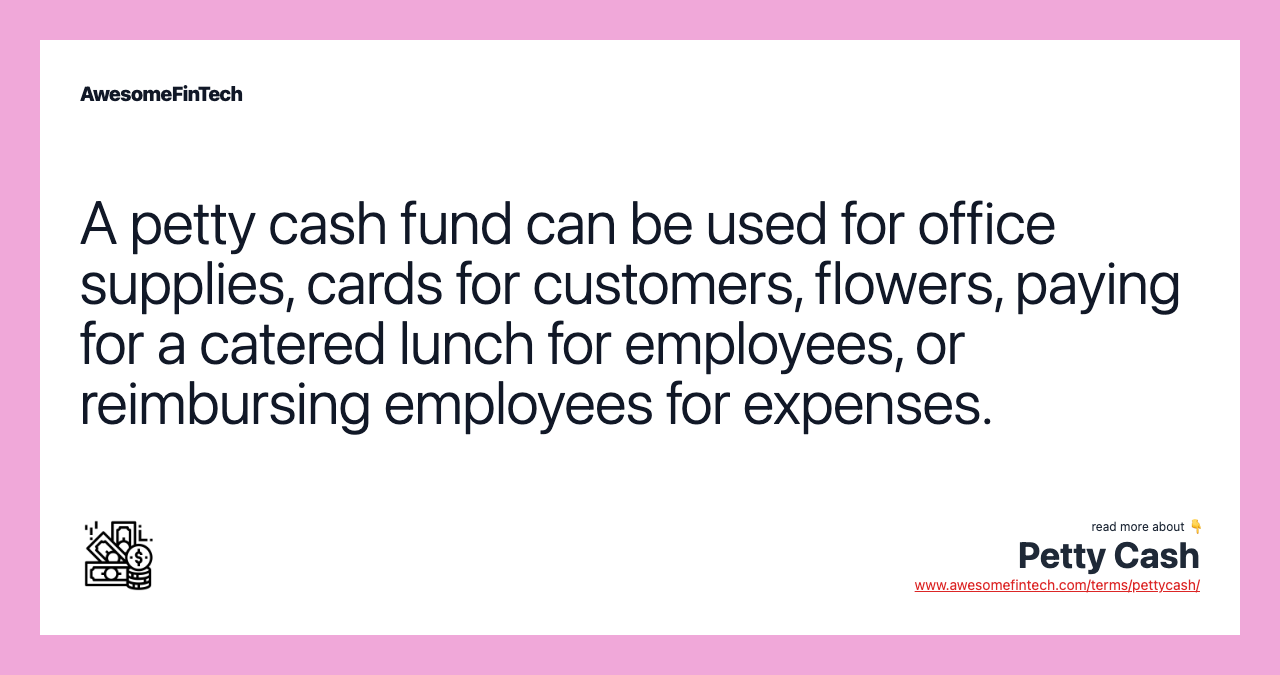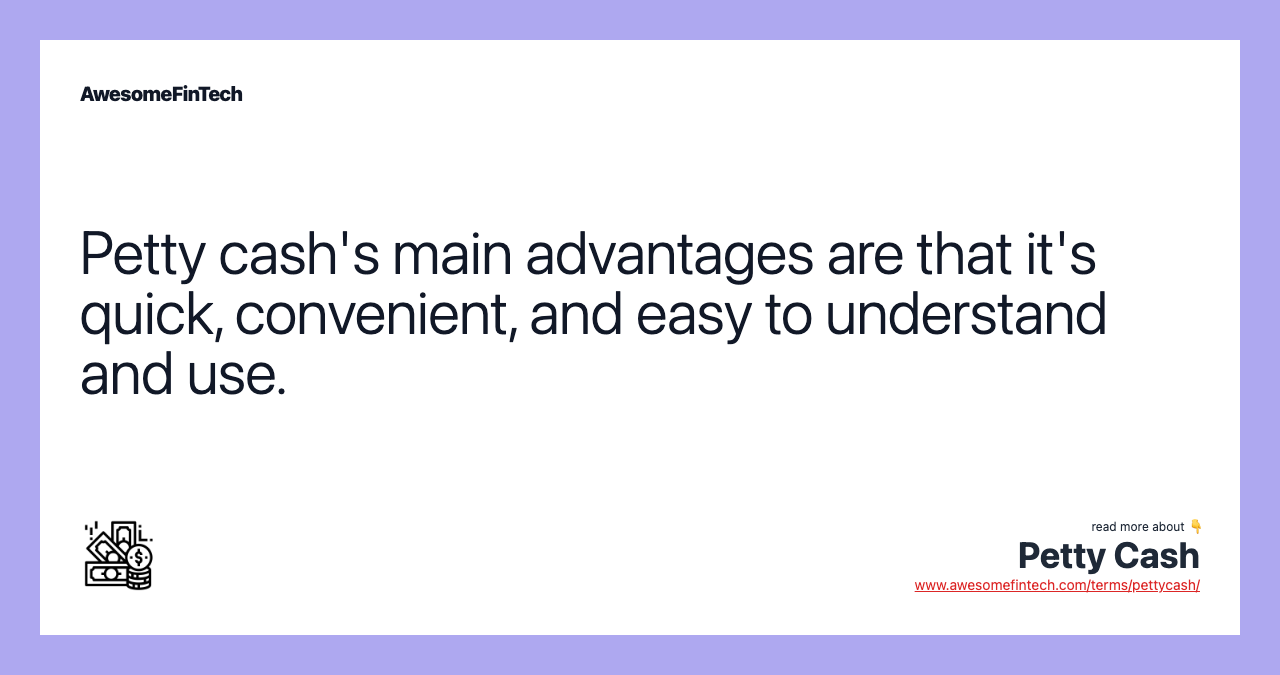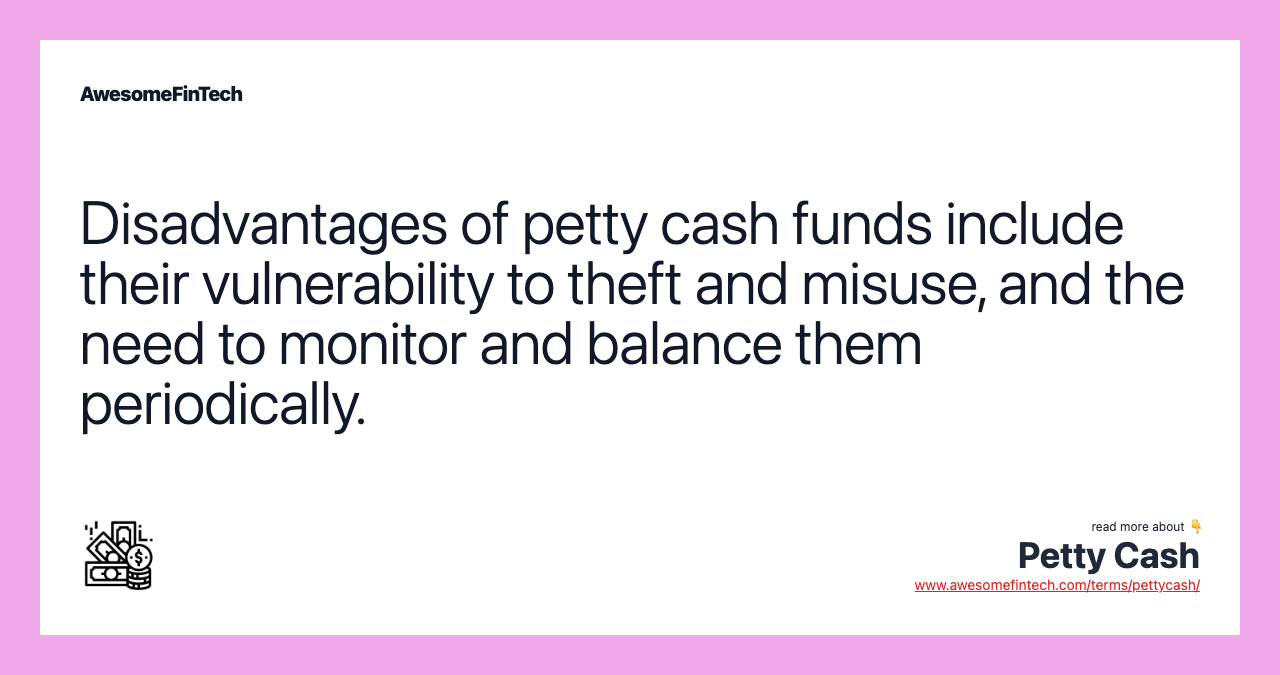Petty Cash
Table of Contents What Is Petty Cash? Understanding Petty Cash Requirements for Petty Cash Recording Petty Cash Reconciling Petty Cash Petty Cash vs. Cash on Hand Pros and Cons of Petty Cash In short: All petty cash is a form of cash on hand, but not cash on hand is petty cash. In this meaning, the difference from petty cash refers to where you're keeping the money, and how you're using it — with petty cash being more for internal business needs/expenses by employees, and cash in hand referring to funds received from or being reimbursed to customers. Examples of transactions that a petty cash fund is used for include: Office supplies Cards for customers Paying for a catered lunch for a small group of employees Reimbursing an employee for small work-related expenses Petty cash fund custodians are appointed to oversee the fund. The journal entry for giving the custodian more cash is a debit to the petty cash fund and a credit to cash.

What Is Petty Cash?
A petty cash fund is a small amount of company cash, often kept on hand (e.g., in a locked drawer or box), to pay for minor or incidental expenses, such as office supplies or employee reimbursements.
A petty cash fund will undergo periodic reconciliations, with transactions also recorded on the financial statements. In larger corporations, each department might have its own petty cash fund.





Understanding Petty Cash
Petty cash provides convenience for small transactions for which issuing a check or a corporate credit card is unreasonable or unacceptable. The small amount of cash that a company considers petty will vary, with many companies keeping between $100 and $500 as a petty cash fund. Examples of transactions that a petty cash fund is used for include:
Petty cash fund custodians are appointed to oversee the fund. The custodial duties generally include enforcing petty cash rules and regulations, requesting replenishments, and dispensing funds.
Requirements for Petty Cash
The use of a petty cash fund can circumvent certain internal controls. However, the availability of petty cash doesn't mean that it can be accessed for any purpose by any person. Many companies employ strict internal controls to manage the fund. Often, a few individuals are authorized to approve disbursements and can only do so for expenses related to legitimate company activities or operations.
A petty cashier might be assigned to issue the check to fund the petty cash drawer and make the appropriate accounting entries. The petty cash custodian is charged with distributing the cash and collecting receipts for all purchases or any uses of the funds. As the petty cash total declines, the receipts should increase and add up to the total amount withdrawn.
By having a petty cash cashier and a petty cash custodian, the dual-process helps to keep the funds secure and ensure that only those authorized have access to it.
Recording Petty Cash
When a petty cash fund is in use, petty cash transactions are still recorded on financial statements. No accounting journal entries are made when purchases are made using petty cash, it’s only when the custodian needs more cash — and in exchange for the receipts, receives new funds — that the journal entries are recorded. The journal entry for giving the custodian more cash is a debit to the petty cash fund and a credit to cash.
If there's a shortage or overage, a journal line entry is recorded to an over/short account. If the petty cash fund is over, a credit is entered to represent a gain. If the petty cash fund is short, a debit is entered to represent a loss. The over or short account is used to force-balance the fund upon reconciliation.
The Internal Revenue Service (IRS) recommends filing out petty cash slips and attaching them to receipts to record and document petty cash expenses.
Reconciling Petty Cash
The petty cash fund is reconciled periodically to verify that the balance of the fund is correct. Typically, as the petty cash balance falls to a preset level, the custodian applies for additional cash from the cashier. At this time, the total of all of the receipts is calculated to ensure that it matches the disbursed funds from the petty cash drawer. If new funds are needed, the cashier writes a new check to fund the petty cash drawer and takes, in exchange, the receipts from the purchases that depleted the cash.
The reconciliation process ensures that the fund's remaining balance equals the difference between the original balance minus charges detailed on receipts and invoices. If the remaining balance is less than what it should be, there is a shortage. If the remaining balance is more than what it should be, there is an overage. Although there can be minor variances, when unbalanced, the source of the discrepancy should be identified and corrected.
Petty Cash vs. Cash on Hand
"Petty cash" and "cash on hand" sound a lot alike, and they do overlap. Of the two, "cash on hand" is the more generic term.
Petty cash refers specifically to money — literally, coins and bills — that a company keeps on hand for small outlays, usually because using cash is easier than using a check or credit card.
Cash on hand is any accessible cash the business or liquid funds have. It can be in the form of actual money, like amounts you haven't yet deposited in the bank or smaller bills and coins that you keep in the cash register to make change for customers. In this meaning, the difference from petty cash refers to where you're keeping the money, and how you're using it — with petty cash being more for internal business needs/expenses by employees, and cash in hand referring to funds received from or being reimbursed to customers.
But cash on hand has a larger meaning, as an accounting term. In the financial world, it also refers to a company's highly liquid assets — funds in checking or other bank accounts, money market funds, short-term debt instruments, or other cash equivalents. Though not literally cash, it's money that can be easily and quickly accessed, which is why it's "on hand."
In short: All petty cash is a form of cash on hand, but not cash on hand is petty cash.
Advantages and Disadvantages of Petty Cash
Petty cash has its pluses. Cash, in many cases, remains the quickest, simplest, easiest way to pay for things. It works well to cover small impromptu expenses — like a tip for the kid delivering pizzas to the lunch meeting, or cab fare home for employees working late. It saves the hassle of reimbursing people or expecting them to pay out-of-pocket for work-related items.
Petty cash can also work for frequent but mundane expenses, like milk for the office fridge, stamps, or cleaning supplies.
While it shouldn't be a habitual practice, petty cash in a pinch can be used to make change for customers, if the till's running short.
On the downside, the convenience of petty cash can also make it a problem, and a risk. Cash is hard to secure and impossible to track; it's very easy for bills to disappear without a trace — even if you've established a careful system of receipts or vouchers.
This brings us to another drawback of petty cash funds: Maintaining them, keeping records, and reconciling them regularly, all involve extra work for someone. This may be a minor nuisance in large firms with an office manager or accounting department; for small businesses, it might create a burden.
Commercial transactions are increasingly cashless — even at small retailers and restaurants, where purchases traditionally have relied heavily on coins. Petty cash has become an outmoded concept, some critics say. In between credit cards, debit cards, payment services like Venmo or Paypal, electronic wallets, and other contactless ways to buy things, plenty of alternatives exist simple as cash — with the added advantages of being traceable, secure, and less subject to theft.
The security aspect is often important to small companies, who have long feared that keeping cash around is an invitation to crime.
Petty Cash FAQs
What Is Petty Cash and What Is It Used For?
Petty cash is the money that a business or company keeps on hand to make small payments, purchases, and reimbursements. Either routine or unexpected, these are transactions for which writing a check or using a credit card is impractical or inconvenient.
Why Is It Called Petty Cash?
The English word "petty" derives from the French petit, which means "small" or "little." Likewise, "petty" means minor or insignificant. So petty cash refers to a small sum of money set aside for trifling or little purchases, as opposed to major expenses or bills.
One of the earliest uses of the phrase comes from an educational work on housekeeping by Benjamin Billingsley, Advice to the women and maidens of London, that dates to 1678.
What Is an Example of Petty Cash?
Petty cash is usually kept in a drawer, lockbox, or large envelope. Typical petty cash purchases include:
Is Petty Cash a Cash Equivalent?
No. Petty cash is actual cash money: bills and coins. Cash equivalents are highly liquid securities and other assets that can be easily converted into cash: money market funds, commercial paper, or short-term debt, like Treasury bills.
However, on corporate financial statements, petty cash is listed in the "Cash and cash equivalents" section of the balance sheet. So the two can be lumped together in that sense.
How Do You Balance Petty Cash in Accounting?
Each time you tap into a petty cash fund — that is, take money out — a slip or voucher should be filled out. This acts as a receipt, logging the amount of the withdrawal, the date, the purpose, and other details. Increasingly, these slips are electronic ones, entered in a digital spreadsheet or ledger. But it can be helpful to keep paper slips too, along with receipts from the purchases or payments (if possible).
After a designated interval — usually, the same time each month or week — it's time to reconcile or balance the petty fund account. First, note the current amount in the fund. Then, subtract this amount from the starting balance. This sum is the total withdrawn from the account during that time period.
Next, total the amount of all the outstanding slips (plus attached receipts). This figure should be the same as the withdrawn sum you calculated from the account starting and ending balances. And the amount of cash you have in your storage box or drawer should be the same as the current balance of the account.
If they don’t match, you’ll have to investigate why: was there a mathematical error? is a receipt missing or incorrect?
Balancing the petty cash account usually occurs when the fund needs to be replenished. The petty cash custodian brings all the slips or vouchers to the business' bookkeeper, cashier, or accountant. The petty cash receipts are logged into the company's General Ledger as credits to the petty cash account, and probably debits to several different expense accounts. When the petty fund is replenished, usually by drawing on a company-issued check, it's recorded as a debit to the petty cash account and a credit to the cash account.
The Bottom Line
Petty cash is a small amount of cash that is kept on a business or company's premises to pay for minor expenses and needs — usually, no more than a few hundred dollars. While it's easy to understand and simple to use, petty cash is subject to abuse, easy to lose track of, and vulnerable to theft. Some feel that in contemporary society, the petty cash fund is outmoded: plenty of alternatives exist for small purchases that are safer and just as convenient.
Related terms:
Cash Position
A cash position represents the amount of cash that a company, investment fund or bank has on its books at a specific point in time. read more
Cash Allowance
A cash allowance is an expense that is repaid immediately in cash, instead of being reimbursed at a later date. read more
Cash And Cash Equivalents (CCE)
Cash and cash equivalents are company assets that are either cash or can be converted into cash immediately. read more
Custodian
A custodian is a financial institution that holds customers' securities in electronic or physical form to minimize the risk of theft or loss. read more
Deposit in Transit
A deposit in transit is money that has been received by a company and sent to the bank, but it has yet to be processed and posted to the bank account. read more
Disbursement
Disbursement is the act of paying out or disbursing money, which can include money paid out for a loan, to run a business, or as dividend payments. read more
Financial Statements , Types, & Examples
Financial statements are written records that convey the business activities and the financial performance of a company. Financial statements include the balance sheet, income statement, and cash flow statement. read more
Imprest
An imprest is an account businesses use to pay for small, routine expenses. A fixed balance is maintained in the account, and it is replenished routinely. read more
Incidental Expenses (IE)
Incidental expenses (IE), also known as incidentals, are tips and other small costs ancillary to a business expense. Learn when incidentals are deductible. read more
Internal Controls
Internal controls are processes and records that ensure the integrity of financial and accounting information and prevent fraud. read more